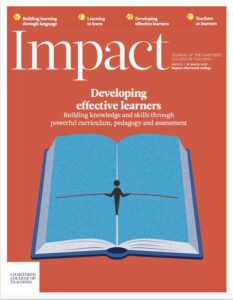Word power: Creating a language-rich environment

Note: The author of this article, Kelly Ashley, works as a consultant offering chargeable support, training and consultancy services to schools on a range of topics including language and literacy development.
Early language and literacy development affects educational attainment and outcomes in later life (Department for EducationThe ministerial department responsible for children’s serv... More, 2017). Effective vocabulary instruction and ‘exposure to a rich language environment with opportunities to hear and confidently experiment with new words’ can boost literacy ((Education Endowment Foundation, 2017), p. 8) But what does this look like in practice? As a primary teacher, I was always looking for ways to improve children’s vocabulary. Drawing on research I’ve looked into as a primary English specialist, this perspective piece aims to demystify evidence-based vocabulary learning approaches and offer practical suggestions for classroom application.
Creating a language-rich environment – help them notice
How often do pupils truly notice the richness of words around them? Increased awareness brings to the forefront both the power of words’ meaning and usage and how, as language-users, we can harness this power when we choose and use words to communicate.
Anderson and Nagy ((Anderson and Nagy, 1992), p.1) describe this interest and awareness of words as ‘word consciousness’. There is a vast library of language that exists in the visual centre of the brain. For pupils who effectively harness the power of words, these volumes are easily organised and categorised, with effective information-retrieval processes, connecting the new with the known.
Graves et al. ((Graves et al., 2011), p.7) highlight that this greater awareness not only ‘involves an appreciation of the power of words’ but also involves ‘an understanding of why certain words are used instead of others’. Effective vocabulary development ensures organisation, classification and selection of language, suited to audience and purpose.
To build pupils’ visual libraries of language, we must ensure regular exposure to new words, in a range of contexts, encouraging articulation of thinking. Beck et al. (Beck et al., 2013) describe classrooms ‘rich in words’, which:
- Ensure a daily ‘diet’ of reading aloud. Cremin et al. ((Cremin et al., 2014), p.4) suggest developing ‘teachers as readers’ to aid in ‘fostering positive attitudes to reading’ in the classroom community. Regularly reading aloud, sharing and discussing high-quality texts can improve fluency and strengthen receptive vocabulary.
- Allow pupils to choose and discuss new words. Classrooms should be a hive of activity. Pupils should be encouraged to co-construct new knowledge about language encountered and to identify target words for discussion. Which are causing a barrier to comprehension? Which are unfamiliar?
- Explore vocabulary across the curriculum. Exploring meaning across domains can deepen understanding. The Primary National Curriculum (2014, p.11) states that ‘pupils’ acquisition and command of vocabulary are key to their learning and progress across the whole curriculum’. Breaking down subject boundaries can clarify and expose multiple meanings across cognitive domains. Divide has a specific meaning in the mathematical domain; however, this knowledge can be applied when exploring the abstract meaning – There was a divide between them that could not be reconciled (a separation).
- Provide visual reminders of new language. Collecting and visually recording new language can help to embed vocabulary learning. Readily accessible word-solving kits (highlighters, post-it notes, coloured pens) and word-solving books (dedicated, personal space for pupils to record new language learned) can be useful tools to capture linguistic discoveries, in the moment. Tennet et al. ((Tennet et al., 2016), p.41) explore ‘visualizing’ as a key skill for developing comprehension, which ‘allows the elements of the text to be captured and… more memorable’. When encountering the word ‘rumble’ in Rumble in the Jungle by Giles Andreae, one pupil may draw a set of drums, another, thunder rumbling across the sky. Both have made a personal connection to support information retrieval.
Direct vocabulary instruction – amplify understanding
Direct vocabulary instruction provides the opportunity to amplify language. Stahl and Fairbanks ((Stahl and Fairbanks, 1986), p.56) found that direct vocabulary instruction is most effective when instruction of words is ‘directly related to content’. Whilst direct instructionA method of instruction in which concepts or skills are taug... More of words, unrelated to context (e.g. word lists, topic words), is more effective than no instruction at all, the most effective model involves exploration of word meanings in context.
Within a language-rich environment, Beck et al. ((Beck et al., 2013), p.14) suggests that ‘students keep using new words so they come to ‘own’’ the words… notice words in their environments whose meanings they do not know… and become aware of and explore relationships among words in order to refine and fully develop word meanings.’
Vocabulary learning strategies, referred to in this piece as Word Attack skills, can be categorised under three ‘lenses’ – key knowledge to draw upon to analyse words. Lenses should be explored in reading and writing contexts. Word learning may occur during reading comprehension activities (read aloud, whole-group reading, small-group reading, etc.) and also during writing activities (shared writing, editing and improving, etc.) Integrating vocabulary instruction is not about finding more time in the already crowded curriculum to teach discrete ‘vocabulary lessons’, but rather about enhancing existing structures, affording opportunities to build receptive and expressive language skills.
To exemplify opportunities for the instruction of Word Attack skills in context, target words have been selected from The Viewer by Shaun Tan and Gary Crew (Crew and Tan, 2012).
Lens 1: Make it personal (connections and personal links)
‘Effective teachers maximise children’s learning potential by responding to their interests and experiences.’ ((Dombey, 2010), p.6) To strengthen connections:
- Explore synonyms and antonyms. Connecting new with known words increases the likelihood of retrieval by association. On page 1, the author describes the main character as ‘always alone… crouched by the seashore, peering at some long-dead life form washed up there’. Synonyms for crouched (huddled, hunched) and antonyms (stretched, straightened) could be explored. Synonyms (lonely) and antonyms (gregarious) for alone can also deepen understanding.
- Investigate meaning in another context. Viewer is an anchor word in the text – key to comprehension. How does the root word (view) unlock meaning? What are other uses for this word? In this story, viewer has a dual-meaning – something used to view objects and one who views others.
To strengthen understanding, teachers can investigate pupils’ personal connections with new words. To understand pupils’ personal links:
- Uncover prior knowledge. Investigate the use of the word washedin the previous extract. What do pupils connect to the word washed? What is another meaning for ‘wash up’? What does ‘washed up’ mean in this context? What clues does the author provide to unlock meaning?
Lens 2: Build on phonic foundations (phonology, graphology and orthography)
The EEF’s Improving Literacy in KS1 guidance ((Education Endowment Foundation , 2016), p.10) states that ‘the purpose of phonics is to quickly develop pupils’ phonemic awareness… their ability to hear, identify and use phonemes (smallest unit of spoken language’. Developing phoneme identity is essential, alongside ‘accurate letter formation… the basis of a fluent handwriting style’ ((Education Endowment Foundation , 2016), p.14). To build on phonology and graphology and develop more accurate spelling:
- Count syllables. Oral repetition aids articulation and recall and can support encoding. ‘The box was crammed with intriguing treasures… devices designed to magnify… or ’ (p. 7) Repeat illuminate, emphasising each syllable – IL/lu/min/ate, il/LU/min/ate, il/lu/MIN/ate, il/lu/min/ATE. Which sounds correct? Why? Where are the syllable breaks in magnify, devices, intriguing?
- Investigate rhyme and alliteration.‘The musty odour of entombed air escaped…’ (p. 5) Rhyming words around this theme (dusty, fusty, rusty) can help pupils to make aural, visual and semantic connections. Alliterative theme words for magnify (maximise, minimise, microscope) provide additional cognitive challenge.
The integration of orthography (the rules of spelling) into pupils’ vocabulary repertoire helps to provide visual connections to spelling conventions. To develop orthography:
- Encourage pattern-decoding. ‘The brain is not a rule-applier, but a pattern-decoder. Successful encoding occurs when the brain recognises a familiar spelling patternor searches through its store of words with similar patterns.’ (Cunningham, (Cunningham, 2013), p.186) Which words fit the pattern ‘i__ate’, as in the word illuminate? (investigate, interrogate, irate) How can this support retrieval of the letter string -ate?
Lens 3: Exploring word meaning (semantics, morphology and etymology)
Biemiller and Boote (Biemiller and Boote, 2006) reinforce that introducing words in context improves word knowledge. To investigate semantics:
- Explore word class. Lack of context breeds ambiguity. Consider different functions of the -ed suffix: ‘Fashioned (verb) from dark wood and burnished (adjective) metal, and covered (verb) with detailed (adjective)..’ (p. 5) Explore how suffixes can be added to change word class.
- Discuss multiple meanings. Word gradients (degrees of meaning) can help clarify. Consider this description of the city dump: ‘a vast crescent with the detritus of a careless people’ (p. 3) What else could be described as vast? Why is vastmore appropriate than bigor tremendous? Where would far-reaching, gigantic, infiniteor limitlessfeature on a word gradient?
Graves ((Graves, 2004), pp.81-99) suggests promise in deconstructing and reconstructing word parts, ‘disassembling and reassembling words’ to derive meaning. To investigate morphology:
- Raise awareness of morphemes – root words, prefixes and suffixes.Skilled morphemic analysis can highlight connections between smaller units of meaning within words. How can the -lesssuffix in carelessbe used to decipher meaning? What are other words that can be created using this suffix? (hopeless, limitless) Would uncaring work in this context? Why not? Word webscan visually map out connections (un-prefix, careroot, -ing suffix).
‘Understanding the history of words and relationships between them can also help with spelling.’ ((Department for Education , 2014), p.72). To investigate etymology:
- Generate an awareness of the history of word roots. The word detritus (waste or debris) will, most likely, be an unfamiliar word to pupils. Harry Potter fans may draw on knowledge of the Eradication Spell (Deletrius) derived from the Latin word delere, meaning ‘to destroy’. Detritus is derived from the Latin detere, meaning ‘to wear away’.
Rosenshine ((Rosenshine, 2012), p.39) affirms that ‘the best way to become an expert is through practice… the more practice, the better the performance.’ Once pupils have practised a range of Word Attack skills, they will have access to a myriad of tools they can use to analyse words. By viewing skills through different ‘lenses’, pupils can self-select tools in their cognitive armoury to tackle unfamiliar words.
Immersion in a language-rich environment within a culture of noticing and appreciating words, coupled with high-quality direct vocabulary instruction to amplify words, is the recipe for fostering pupils’ Word Power. By taking control of this power, pupils will strengthen knowledge of the interconnection between the words we use to communicate.










